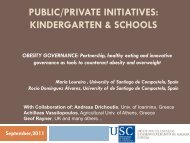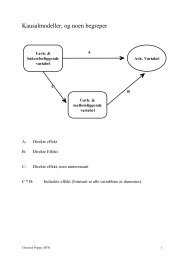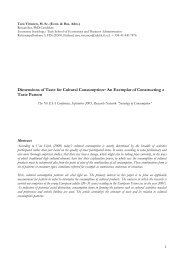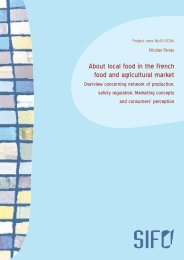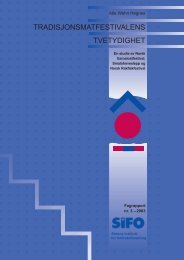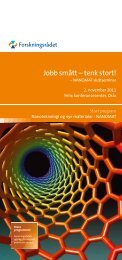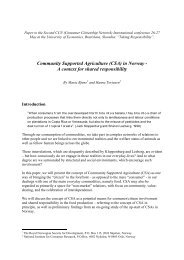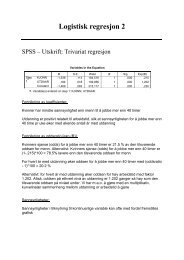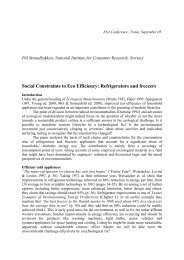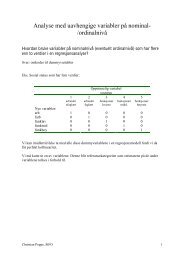an investigation of domestic laundry in europe - habits ... - SIFO
an investigation of domestic laundry in europe - habits ... - SIFO
an investigation of domestic laundry in europe - habits ... - SIFO
Create successful ePaper yourself
Turn your PDF publications into a flip-book with our unique Google optimized e-Paper software.
Assessment <strong>of</strong> the functional perform<strong>an</strong>ce <strong>of</strong> Europe<strong>an</strong> <strong>laundry</strong> processes <strong>an</strong>d detergents 51Reflect<strong>an</strong>ce measurements <strong>of</strong> the washed soiled test fabrics are made with aspectral photometer. This measurement <strong>of</strong> the tristimulus value Y is used as ameasure <strong>of</strong> the wash perform<strong>an</strong>ce. The ma<strong>in</strong> spectral photometer used <strong>in</strong> thesemeasurements is a M<strong>in</strong>olta CM-3610d with SpektraMagic s<strong>of</strong>tware. Some <strong>of</strong>the measurements are made with a M<strong>in</strong>olta CM-508d to ga<strong>in</strong> time. To elim<strong>in</strong>ate<strong>an</strong>y differences this might have caused, we used the same spectral photometerto measure the same soiled test fabrics. All results are shown as <strong>an</strong>average <strong>of</strong> the reflect<strong>an</strong>ce values <strong>of</strong> all soil types used, except for the detergentsfor coloured textiles. When evaluat<strong>in</strong>g these we have excluded the soilsfor detect<strong>in</strong>g bleach<strong>in</strong>g effects. We have used a 95 % level <strong>of</strong> confidence todeterm<strong>in</strong>e whether the differences are signific<strong>an</strong>t.Determ<strong>in</strong>ation <strong>of</strong> the r<strong>in</strong>se efficiencyAs a method to f<strong>in</strong>d r<strong>in</strong>se efficiency we have used the test described <strong>in</strong> IEC60456:1998 [9]. This is a test us<strong>in</strong>g the residual alkal<strong>in</strong>ity <strong>of</strong> the detergentsolution <strong>in</strong> a base load after sp<strong>in</strong> extraction as a measure <strong>of</strong> r<strong>in</strong>se efficiency.The <strong>in</strong>creased alkal<strong>in</strong>ity concentration <strong>in</strong> the sp<strong>in</strong> extracted water from thebase load is used, related to the alkal<strong>in</strong>ity concentration <strong>in</strong> the water supply.To f<strong>in</strong>d this we need samples from the water supply dur<strong>in</strong>g tests. Three samplesare taken from the water supply at different stages <strong>of</strong> the wash cycle.These samples are measured for pH, water hardness (°dH) <strong>an</strong>d water <strong>in</strong>lettemperature. To f<strong>in</strong>d the alkal<strong>in</strong>ity, 100 grams <strong>of</strong> the water supply sample istitrated with 0.02 N HCl to 4.0 pH at a specific time us<strong>in</strong>g a microburette.After a complete wash cycle, the test load is removed immediately <strong>an</strong>d theweight <strong>of</strong> the base load is measured to calculate the rema<strong>in</strong><strong>in</strong>g moisture. Thebase load is tr<strong>an</strong>sferred to <strong>an</strong> external sp<strong>in</strong> extractor <strong>an</strong>d the residual water isextracted to f<strong>in</strong>d the residual alkal<strong>in</strong>ity <strong>in</strong> the base load. The base load wasspun with the external sp<strong>in</strong> extractor for 5 m<strong>in</strong>utes. This yielded a detergentsolution that we mixed thoroughly <strong>an</strong>d divided <strong>in</strong>to three test samples formeasur<strong>in</strong>g alkal<strong>in</strong>ity.The extracted test samples were measured to f<strong>in</strong>d the alkal<strong>in</strong>ity, us<strong>in</strong>g thesame method as for the water supply samples. Dur<strong>in</strong>g the r<strong>in</strong>se efficiency testswith the 30 °C wash programme, we found that some detergents gave a lowerresidual moisture level th<strong>an</strong> we had expected. Because <strong>of</strong> this we reduced thevolume <strong>of</strong> the test samples for tests with the 40 °C wash programme. For testsamples from these tests, only 50 grams <strong>of</strong> detergent solution were used.



